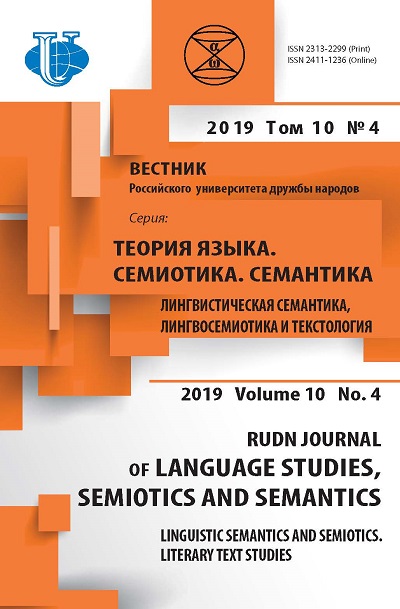Cluster Analysis of Polysemous Word Semantic Structure in the Light of Invariant Theory
- Authors: Zimareva O.L.1, Pesina S.A.1
-
Affiliations:
- Nosov Magnitogorsk State Technical University
- Issue: Vol 10, No 4 (2019): Linguistic Semantics and Semiotics. Literary Text Studies
- Pages: 860-870
- Section: FUNCTIONAL SEMANTICS
- URL: https://journals.rudn.ru/semiotics-semantics/article/view/22772
- DOI: https://doi.org/10.22363/2313-2299-2019-10-4-860-870
- ID: 22772
Cite item
Full Text
Abstract
The aim of the article is to disclose specific features of the cluster method of material organization to the semantic structure analysis of polysemous words. The object of study includes the most frequent polysemous words of Russian and English languages. The words for study should have a developed semantic structure thanks to which intra-word connections and a picture of the semantic component selection in the process of decoding figurative meaning can be visually presented. The main method of analysis is component analysis and consideration of non-trivial semantic components. In the process of word analysis, we intend to discover what underlies the retention of meanings within a single structure. Initially, the idea bases on the existence of some invariant content, which is stored in the folded form in the mind of a native speaker. In the present study, the application of cluster theory to the organization of the polysemous word semantic structure not only confirms the invariant theory, but also brings it to a new level of understanding what the meaning of the word is and how we understand the figurative meaning. Representation of the semantic structure in the form of interconnected semantic components, united in clusters on the basis of a criterion, represents a new approach to understanding the phenomenon of polysemy and explaining the diffusivity of figurative meanings. The configuration of invariant and differential components in the decoding process provides an understanding of figurative meanings. We find confirmation of this theory in the works on neurolinguistics and cognitive psychology.
About the authors
Olga Leonidovna Zimareva
Nosov Magnitogorsk State Technical University
Author for correspondence.
Email: olgalatushkina87@mail.ru
Candidate of Philology, Docent of the Linguistics and Translation Department at Nosov Magnitogorsk State Technical University
st. Lenina 38, Magnitogorsk, Russian Federation, 455000Svetlana Andreevna Pesina
Nosov Magnitogorsk State Technical University
Email: spesina@bk.ru
Doctor of Philology, Doctor of Philosophy, Professor of the Linguistics and Translation Departmen of Nosov Magnitogorsk State Technical University
st. Lenina 38, Magnitogorsk, Russian Federation, 455000References
- Zimareva, O.L. (2017). Polysemous word research in the light of invariant theory and anthropomorphic approach (using the example of a lexical group ‘Plant’). Thesis for a degree of Candidate of Philological Studies. URL: http://www.bashedu.ru/dissovets?d=11 (accessed: 12.04.2018).
- Turdakov D.Yu., Andrianov I.A., Astrakhantsev N.A., Maiorov V.D., Nedumov Ya.R., Sysoev A.A., Fedorenko D.G. (2014). Text semantic analysis using system Texterra. Report thesis of international conference “Dialog” URL: http://www.dialog21.ru/digests/dialog2014/ materials/pdf/TurdakovDY.pdf (accessed: 08.03.2019).
- Tryon, R.C. (1939). Cluster analysis. London: Ann Arbor Edwards Bros.
- Dyuran, B. & Odell, P. (1977). Cluster analysis. Moscow: Statistika.
- Mandel', I.D. (1988). Cluster analysis. Moscow: Finansy i statistika.
- Kalinina, V.N. & Solov'ev, V.I. (2003). Introduction of multidimensional statistics analysis / GUU. Moscow.
- Baarsa, B. & Geidzh, N. (2014). Brain, cognition, mind: introduction to cognitive neuroscience: Vol. 2. Ch. 2. Prof. V.V. Shul'govski (Ed.). Moscow: BINOM, Laboratoriya znanii.
- Arkhipov, I.K. (2001). Cognitive and logic analysis in lexicographic practice In Human factor in language: teaching aid (course materials). Saint Petersburg: Nevskii in-t yaz. i kul'tury. pp. 39—57.
- Pesina, S.A. (2011). Word in cognitive aspect. Moscow: FLINTA: Nauka.
- Vygotskii, L.S. (2003). Phycology of human. Moscow: Eksmo.
- Luriya, A.R. (1979). Language and consciousness, E.D. Khomskaya (Ed.). Moscow: Publising house of Moscow university.
- Luriya A.R. (1973). Neurophycology of memory. Moscow.
- Kuhn, T.S. (1962). The structure of scientific revolutions. Chicago: The University of Chicago Press.
- Brain, W.R. (1941). Visual disorientation with special references to lesions of the right cerebral hemisphere In Brain 64.
- Hecaen, H. (1969). Aphasie, apraxic & agnostic syndromes in right and left hemisphere lesions In P.J. Vinken and G.W. Bruyn. Handbook of clinical, neurol. Amsterdam. Vol. 4. pp. 290—311.
- Hodges, J.R. & Patterson, K. (1997). Semantic memory disorders, Trends in Cognitive Sciences, 1(2), 68—72.
Supplementary files












